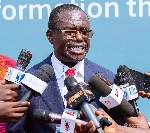BoG raises policy rate to 19%
 Central Bank Governor Dr Ernest Addison
Central Bank Governor Dr Ernest Addison
The Monetary Policy Committee of the Bank of Ghana has raised the policy rate by 200 basis points to 19 per cent.
At a press briefing, the central bank said: “In sum, the Committee observed that the global growth recovery is showing signs of a slowdown, on account of heightened risks emanating from lingering supply chain bottlenecks, China’s zero-Covid policy, and the Russia-Ukraine war. Concurrent with the growth slowdown is the sharp rise in inflation across several advanced and emerging market economies, which has posed some challenges to central banks globally. Global price pressures have broadened beyond the volatile items of energy and food. This has prompted some coordinated monetary policy tightening in Advanced Economies and most Emerging Market and Developing Economies and triggered tightened global financing conditions. The spillover effects of these policy responses have impacted economies through the trade and finance channels, with vulnerable developing countries faced with capital flow reversals and currency pressures. Ghana’s economy is already facing some of these headwinds from these spillover effects”.
It said growth prospects in the domestic economy remain positive and the Bank’s high-frequency indicators point to continued and increased momentum in economic activities with private sector credit showing some improvement in real terms, despite the increased price pressures.
“All these are resulting in a closure of the negative output gap. The banking sector remains robust, with sustained growth in total assets, investments and deposits. However, business and consumer confidence have dipped, reflecting the sharp depreciation of the currency and the general high inflationary environment, which has resulted in higher input costs for businesses. A quick turnaround, with more confidence-building measures to counter these conditions, would provide further boost to the real economy”, it added.
On fiscal policy implementation, the Committee observed that execution of the budget for the first quarter was broadly in line with targets although there was a minor deviation in the deficit target, stemming largely from low revenue receipts.
It is the expectation of the Committee that fiscal consolidation will take hold gradually and the mid-year budget review will provide further fiscal fine-tuning to ensure that the fiscal consolidation efforts stay on track.
The MPC said despite the improvement in the trade balance due to favourable commodity prices, the external sector has weakened somewhat due to developments in the capital and financial account.
Also, it said the domestic economy does not fully benefit from higher oil and gold prices due to retention agreements in these sectors. The increased repatriation from dividend payments and profits, as well as the net portfolio reversals, have resulted in a widened balance of payments outturn and loss of reserves. The prevailing tight global financing conditions, and further policy rate hikes in Advanced Economies continue to pose risks to the external outlook.
“Headline inflation surged in April 2022. And, both headline and core inflation have stretched further above the upper limit of medium-term target band. The heightened uncertainty surrounding the inflation dynamics has weighed heavily on the domestic environment and significantly depressed business and consumer sentiments”, adding: “The inflation numbers show that while food inflation has accounted for the increases in inflation over the past year, the recent jump in April shows that relative price increases in the non-food sector is accelerating at a fast pace, which provides information on the extent to which prices are becoming embedded”.
The MPC said the bank’s latest forecast shows a continued elevated inflation profile in the near term, with a prolonged horizon for inflation to return to the target band. Inflation expectations by consumers, businesses and the banking sector have also heightened. The risks to the inflation outlook are on the upside, and emanate from availability of inputs for food production, imported inflation, continued upward adjustments in ex-pump petroleum prices and transportation costs, possible increases in utility tariffs, and potential wage pressures. The second-round effects of these administered price adjustments would further amplify inflation pressures in the outlook.
“These considerations show that with the strong rebound in growth and the closing of the negative output gap, the balance of risk is clearly on inflation. The MPC took the view that it needed to decisively address the current inflationary pressures to re-anchor expectations and help foster macroeconomic stability”.
“On the basis of the above assessment, the Committee decided to raise the policy rate by 200 basis points to 19.0 per cent”.
Read Central Bank Governor Dr Ernest Addison’s full statement below:
Good morning, Ladies and Gentlemen of the Media and welcome to the Press briefing after the 106th Monetary Policy Committee meetings which took place last week. I am pleased to be here with Deputy Governors, Dr. Opoku-Afari and Mrs. Awadzi, together with the Directors of Research and Financial Markets, who are the internal members of the MPC.
As you know, we also have two external members, Professors Abor and Turkson, both of the University of Ghana. The Committee deliberated on recent global developments and how they continue to shape global macroeconomic conditions and with spillovers to the domestic economy. An assessment of macroeconomic conditions for the first four months of 2022 and its implications for the outlook for inflation and growth provided the key considerations that the Committee took into account in its decision on the stance of monetary policy.
The Committee noted that since the last MPC meeting in March 2022, global headwinds have intensified, underpinned by the spillover effects of the Russia-Ukraine war and China’s zero-Covid policy. Particularly, the war has worsened pre-existing global supply chain disruptions, triggered food and energy price shocks, and further heightened uncertainty about global growth prospects. The quick turnaround from accommodative policies that characterised monetary policy conduct in Advanced Economies over the past two years, and the slowdown in China’s growth are expected to adversely impact the macroeconomic outlook for most Emerging Market and Developing Economies. The IMF, during the 2022 Spring Meetings, revised Global growth forecasts downwards to 3.6 percent in 2022 from 6.1 percent in 2021.
Global price pressures remain elevated, primarily due to escalating energy and other commodity prices, as well as the persistent and broadened supply chain bottlenecks. As a result, headline inflation has not only breached the set targets across several Advanced and Emerging Market and Developing Economies, but also reached record high levels, not seen in several decades. These trends have prompted swift and coordinated monetary policy responses by major central banks. The U.S. Federal Open Market Committee and the Bank of England have hiked interest rates and signalled further rate increases to address inflationary pressures, while the European Central Bank is expected to curtail the net asset purchase programme by the third quarter. Similarly, policymakers in several Emerging Market and Developing Economies have moved towards policy tightening in response to rising inflation and currency pressures.
The shift towards less accommodative monetary policy stances to contain inflationary pressures has resulted in tighter global financing conditions with negative spillover effects to emerging market and frontier economies. The strengthening of the U.S. Dollar and rising long-term bond yields, have led to widened sovereign bond spreads, and capital flow reversals as well as currency pressures, especially for Emerging Market and Developing Economies with weaker fundamentals and less buffers.
On the domestic front, data from the Ghana Statistical Service showed that the economy has rebounded strongly from the impact of the Covid-19 pandemic, stemming largely from all the policy measures that were put in place to forestall a recession. This is evidenced by the strong real GDP growth outturn of 5.4 per cent reported for 2021, compared with 0.5 per cent in 2020. Non-oil GDP grew at a stronger pace by 6.9 per cent in 2021, significantly up from 1.0 per cent in 2020. The strong pick-up in economic activity was largely driven by the services and agriculture sectors.
Information from the Bank of Ghana’s updated Composite Index of Economic Activity (CIEA) shows that the observed strong growth momentum will likely persist in the first quarter of 2022. The CIEA recorded an annual growth of 4.6 per cent in March 2022, compared to 4.2 and 4.4 per cent in January and February, respectively. Available data show that exports are picking up, credit to the private sector continues to recover, together with an uptick in industrial production. The improvement in Domestic VAT suggests demand is picking up, and higher tourist arrivals were also recorded. These were the variables that drove the rise in the index.
The pace of growth in broad money supply (M2+) slowed in April 2022 on account of a contraction in Net Foreign Assets (NFA) of the banking sector, despite significant expansion in Net Domestic Assets. Annual growth in M2+ moderated to 19.9 per cent in April 2022, compared with 25.8 per cent in the same period of 2021. In terms of components, the moderation in M2+ was reflected in currency outside banks, demand deposits, and savings and time deposits. Foreign currency deposits, however, recorded some growth over the review period. Annual growth in reserve money was 33.8 per cent, compared with 32.0 per cent growth, over the same comparative period.
Credit to the private sector showed considerable improvement, almost back to pre-pandemic levels and broadly in line with the uptrend in economic activities. In nominal terms, private sector credit recorded a significant annual growth of 26.5 per cent in April 2022, compared with 6.9 per cent, in April 2021. In real terms, however, private sector credit grew by 2.3 per cent, due to sustained price pressures, relative to a contraction of 1.5 per cent recorded for the same comparative period. In terms of new advances, the data shows that credit growth continued to improve, reaching GH¢16.4 billion, representing a 56.5 per cent year-on-year growth. The latest credit conditions survey revealed that banks are however beginning to tighten credit stance on loans to enterprises and households. Despite the tightening of credit conditions, demand for credit by households and firms continue to remain strong.
The latest confidence surveys conducted in April 2022, showed some easing of sentiments. Consumer confidence dipped on account of increases in fuel prices and transportation costs, as well as rising inflation. Business sentiments also dipped on concerns that price pressures and currency depreciation would adversely impact industry prospects. The survey findings were broadly aligned with observed trends in Ghana’s Purchasing Managers’ Index (PMI), which reflected declines in both output and new orders.
Developments in the banking sector indicated strong performance, despite the reversal of the COVID-19 regulatory relief measures in March 2022. Total assets rose to GH¢194.3 billion at end-April of 2022, which represented 24.8 per cent annual growth, relative to 16.4 per cent growth in the previous year. The growth was underscored by increased deposits and borrowings. Total deposits grew by 21.3 per cent to GH¢127.2 billion, while borrowings recorded a strong growth of 66.2 per cent to GH¢25.9 billion at end-April 2022.
The key Financial Soundness Indicators remained strong, with the Capital Adequacy Ratio at 21.3 per cent, well above the regulatory minimum of 13.0 per cent. Core liquid assets to short-term liabilities improved to 28.2 per cent in April 2022, compared with 24.9 per cent a year earlier. The Non-Performing Loan ratio eased to 14.3 per cent at end-April 2022, compared with 15.5 per cent in the previous year, signalling some improvement in asset quality during the year.
In the first four months of 2022, banks’ profit before tax was GH¢2.9 billion, representing a 26.3 per cent growth, compared with 39.6 per cent growth for the same period of last year. Net interest income grew by 12.2 per cent to GH¢4.6 billion, compared to 18.4 per cent growth a year ago. Net fees and commissions grew by 17.7 per cent to GH¢1.1 billion, compared with 26.5 per cent growth last year, due to decline in trade finance-related activities in the economy. Other income increased to GH¢1.0 billion, representing 117.5 per cent growth, relative to the contraction by 7.9 per cent last year. These developments resulted in a 22.1 per cent jump in operating income to GH¢6.7 billion, compared with 16.8 per cent growth in the corresponding period of 2021. Operating expenses recorded 23.0 per cent growth compared to 1.7 per cent growth in the previous year.
Recent price developments indicate elevated pressures arising from the sharp increase in global energy and commodity prices, and the consequential effects on domestic ex-pump petroleum prices and transportation costs, food prices, as well as the pass-through effects of the recent exchange rate depreciation. The two inflation readings, since the last MPC, showed that headline inflation further surged from 15.7 per cent in February 2022 to 19.4 per cent in March, and 23.6 per cent in April. The price pressures are increasingly becoming broad-based and reflected in almost all components of the consumer basket, from both domestic and imported sources. Non-food inflation went up significantly from 17.0 per cent in March to 21.3 per cent in April 2022, while food inflation also rose further from 22.4 per cent to 26.6 per cent over the same comparative period.
At the same time, the Bank’s core inflation measure, which excludes energy and utility prices, picked up from 15.4 per cent in February 2022 to 18.5 per cent in March, and further up to 22.3 per cent in April.
On budget execution, provisional data for the first quarter of 2022, indicated an overall broad fiscal deficit (cash, excluding energy sector payments, financial sector clean-up costs) of 2.6 per cent of GDP, against the programmed target of 2.3 per cent of GDP. The corresponding primary balance for the period was a deficit of GH¢2.3 billion (0.5 per cent of GDP), against a deficit target of GH¢1.4 billion (0.3 per cent of GDP). Over the period, total revenue and grants amounted to GH¢16.7 billion (3.3 per cent of GDP), below the projected GH¢19.3 billion (3.8 per cent of GDP). Total expenditures amounted to GH¢27.0 billion (5.4 per cent of GDP), below the programmed target of GH¢30.5 billion (6.1 per cent of GDP).
The stock of public debt increased to 78.0 per cent of GDP (GH¢391.9 billion) at the end of March 2022, compared with 76.6 per cent of GDP (GH¢351.8 billion) at the end of December 2021. Of the total debt stock, domestic debt was GH¢189.9 billion (37.8 per cent of GDP), while the external debt was GH¢201.9 billion (40.2 per cent of GDP).
Developments in the money market reflected upward trends across the entire spectrum of the yield curve, reinforced by the moderation in liquidity conditions in the various market segments. From December 2021 to March 2022, the following was observed regarding movements in the rates:
· The 91-day and 182-day Treasury bill rates have increased to 16.22 per cent and 16.72 per cent respectively, from 12.49 per cent and 13.19 per cent respectively.
· The rate on the 364-day instrument also increased to 18.93 per cent from 16.49 per cent.
· Rates on the 2-year, 3-year, and 5-year bonds also went up.
· On the secondary market, rates on the 6-year, 7-year, 10-year, 15-year, and 20-year bonds all increased.
The weighted average interbank rate increased to 16.46 per cent, from 13.57 per cent in tandem with the 250 basis points policy rate hike in March 2022. This has also transmitted to the retail-end of the market, and average lending rates have inched up to 21.61 per cent in April 2022 from 20.04 per cent in December 2021.
Commodity prices have remained volatile due to the ongoing geopolitical tensions. Average crude oil prices gained 42.0 per cent on a year-to-date basis to settle at US$106.2 per barrel in April 2022, supported by supply constraints arising from the geopolitical tensions between Russia and Ukraine. Gold prices also gained 8.1 per cent to settle at US$1,935.89 per fine ounce, on the back of increased safe-haven demand amid global inflation concerns. Similarly, cocoa prices went up by 4.4 per cent to settle at US$2,591.06 per tonne in April 2022, compared to the US$2,481.95 per tonne in December 2021, due to unfavourable weather conditions across West Africa.
The favourable commodities price trends positively impacted the trade account, as export inflows outweighed imports. Provisional data indicates a trade surplus of US$1.3 billion in the first four months of the year, compared with a trade surplus of US$778.00 million in the same period of last year. The improvement in export earnings was attributed to crude oil and non-traditional exports. Crude oil export receipts recorded significant growth of 61.0 per cent to US$1.9 billion, due to price effects, while gold exports improved by 3.6 per cent, also supported by price effects. Non-traditional export receipts crossed the US$1.0 billion mark in the review period and contributed significantly to the trade surplus. These developments far outweighed the 7.7 per cent growth in total oil imports in the review period, on the back of compressed non-oil imports.
The trade surplus was offset by investment income outflows and net services payments, resulting in a current account deficit of US$128.15 million (0.2 per cent of GDP) for the first quarter of the year, representing a marginal improvement from the current account deficit of US$197.0 million (0.2 per cent of GDP) recorded in the first quarter of 2021. The capital and financial account, however, recorded some significant outflows from net portfolio reversals and net private capital outflows, which resulted in an overall balance of payments deficit of US$934.46 million for the first quarter of 2022, compared with a deficit of US$429.93 million, same time last year.
Gross International Reserves (GIR), at the end of April 2022, stood at US$8.34 billion, equivalent to 3.7 months of import cover. This compares with US$9.70 billion, equivalent to 4.3 months of import cover at end-December 2021.
In the foreign exchange market, the Ghana Cedi depreciated by 15.6 per cent against the US dollar, 13.1 per cent against the Pound Sterling, and 13.6 per cent against the Euro, during the first quarter of 2022. From the beginning of April through the 18th May 2022, there has been some moderation in the rate of depreciation. The Ghana Cedi depreciated by 0.2 per cent against the US dollar, but appreciated by 5.7 per cent against the Pound Sterling and 5.4 per cent against the Euro, bringing the year-to-date depreciation against these currencies to 15.8 per cent against the US dollar, 8.2 per cent against the Pound Sterling, and 8.9 per cent against the Euro.
Summary and Outlook
In sum, the Committee observed that the global growth recovery is showing signs of a slowdown, on account of heightened risks emanating from lingering supply chain bottlenecks, China’s zero-Covid policy, and the Russia-Ukraine war. Concurrent with the growth slowdown is the sharp rise in inflation across several advanced and emerging market economies, which has posed some challenges to central banks globally. Global price pressures have broadened beyond the volatile items of energy and food. This has prompted some coordinated monetary policy tightening in Advanced Economies and most Emerging Market and Developing Economies and triggered tightened global financing conditions. The spillover effects of these policy responses have impacted economies through the trade and finance channels, with vulnerable developing countries faced with capital flow reversals and currency pressures. Ghana’s economy is already facing some of these headwinds from these spillover effects.
Growth prospects in the domestic economy remain positive and the Bank’s high-frequency indicators point to continued and increased momentum in economic activities with private sector credit showing some improvement in real terms, despite the increased price pressures. All these are resulting in a closure of the negative output gap. The banking sector remains robust, with sustained growth in total assets, investments and deposits. However, business and consumer confidence have dipped, reflecting the sharp depreciation of the currency and the general high inflationary environment, which has resulted in higher input costs for businesses. A quick turnaround, with more confidence-building measures to counter these conditions, would provide further boost to the real economy.
On fiscal policy implementation, the Committee observed that execution of the budget for the first quarter was broadly in line with targets although there was a minor deviation in the deficit target, stemming largely from low revenue receipts. It is the expectation of the Committee that fiscal consolidation will take hold gradually and the mid-year budget review will provide further fiscal fine-tuning to ensure that the fiscal consolidation efforts stay on track.
Despite the improvement in the trade balance due to favourable commodity prices, the external sector has weakened somewhat due to developments in the capital and financial account. The domestic economy does not fully benefit from higher oil and gold prices due to retention agreements in these sectors. The increased repatriation from dividend payments and profits, as well as the net portfolio reversals, have resulted in a widened balance of payments outturn and loss of reserves. The prevailing tight global financing conditions, and further policy rate hikes in Advanced Economies continue to pose risks to the external outlook.
Headline inflation surged in April 2022. And, both headline and core inflation have stretched further above the upper limit of medium-term target band. The heightened uncertainty surrounding the inflation dynamics has weighed heavily on the domestic environment and significantly depressed business and consumer sentiments. The inflation numbers show that while food inflation has accounted for the increases in inflation over the past year, the recent jump in April shows that relative price increases in the non-food sector is accelerating at a fast pace, which provides information on the extent to which prices are becoming embedded. The Bank’s latest forecast shows a continued elevated inflation profile in the near term, with a prolonged horizon for inflation to return to the target band. Inflation expectations by consumers, businesses and the banking sector have also heightened. The risks to the inflation outlook are on the upside, and emanate from availability of inputs for food production, imported inflation, continued upward adjustments in ex-pump petroleum prices and transportation costs, possible increases in utility tariffs, and potential wage pressures. The second-round effects of these administered price adjustments would further amplify inflation pressures in the outlook.
These considerations show that with the strong rebound in growth and the closing of the negative output gap, the balance of risk is clearly on inflation. The MPC took the view that it needed to decisively address the current inflationary pressures to re-anchor expectations and help foster macroeconomic stability.
On the basis of the above assessment, the Committee decided to raise the policy rate by 200 basis points to 19.0 per cent.
Source: Classfmonline.com
Trending Business

ECG unveils “Operation Keep the Lights On” revenue mobilisation drive
12:57
B/R: Techiman Central market traders count their loses after fire razed down Alaata area
20:03
I’ll focus on the development of the real sector - Dr Ato Forson
07:29
Dr. Agyepong pledges support for 24-hour economy vision at JLC 2025
07:24
Businesses to see tax reliefs as Ato Forson promises VAT reforms
07:13
Ato Forson demonstrates a profound understanding of the economy - Steve Manteaw
07:06
Jospong executives launch Joseph Siaw Jospong Foundation to support young entrepreneurs
06:57
John Jinapor raises alarm over $3 billion energy sector debt
11:37
President Mahama blames Akufo-Addo administration for $2.5 billion energy sector debt
14:40
Finance Minister-designate vows to bring inflation back to single digit
12:21




